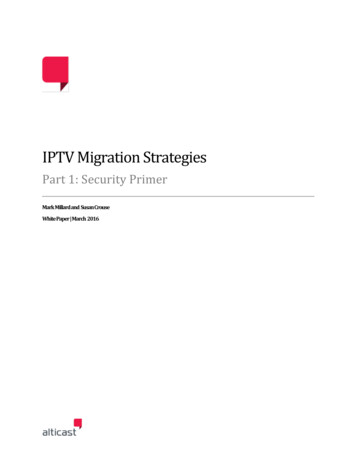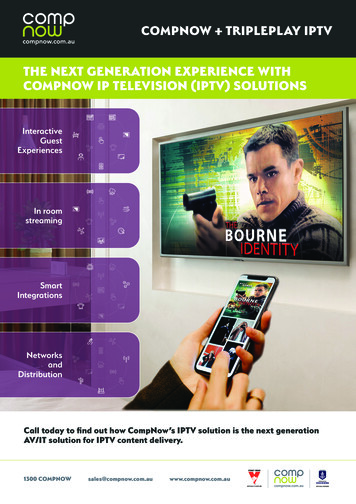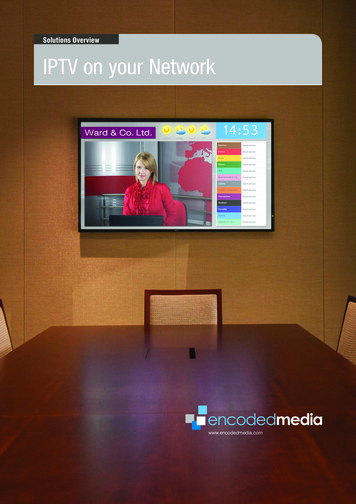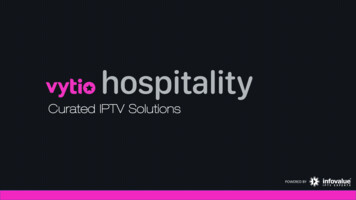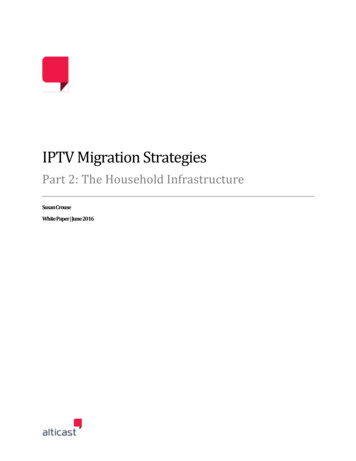
Transcription
ctureSusanCrouseWhitePaper June2016
ContentsExecutive Summary31. Setting the Stage1.1. Content Rights1.2. Household Infrastructures4441.1.1 Wi-Fi Continuity in the Home1.1.2 Wired vs Wi-Fi1.1.3 Device Support1.1.4 Hardware Environment1.3. Network Support1.4. QoS1.5. IPTV Benefits1.1.5 Big Data1.1.6 Improved Service Tools1.1.7 Future act Alticast12AlticastConfidential 2016
ExecutiveSummaryIt is important totake a good lookat the effect ofthe householdinfrastructurewhen making thetransition from aQAM basedvideoinfrastructure toan IPTV deliverymodel.Part 2 of this series on IPTV will cover the challenges that CableOperators face in and out of the household. As a brief refresher from Part1 (Security for IPTV), MSOs see a number of advantages in deliveringvideo over IP, including opening their markets, providing TV Everywhere,competing with OTT services, and more. IPTV could potentially capturenew viewers, provide new services and bring new revenue to Cable.Changing the media delivery method means examining every part of thebusiness model to ensure success; in this paper we focus onunderstanding the household infrastructure.Cable operators have set a high standard for video service quality.Customers expect crisp video without interruption from their cableproviders. In contrast, as IPTV OTT services have grown, users haveneeded to accept interruptions of the video stream transmission, andbuffering events when the streaming fails. OTT’s use of adaptive bit rate(ABR) streaming has helped to alleviate buffering, but at a cost: Thealgorithm keeps the stream flowing by dropping the resolution of thepicture dynamically when bandwidth availability varies, causing the qualityof the video to be degraded.As more and more IP bandwidth is soaked up by the demands of multipledevices and services, the challenges of delivering high quality streamingvideo are exacerbated. While customers can ratchet up their broadbandaccounts – increasing revenue for cable operators – at some pointoperators may face key questions: Are they willing to downgrade videoquality to deliver IPTV? Or are there solutions for ensuring they candeliver the video quality that meets their current standards?It is important to take a thorough look at the effect of the householdinfrastructure when making the transition from a QAM based videoinfrastructure to an IPTV delivery model. According to Digitalsmiths Q42015 Video Trends Report, nearly 55% of US households pay for OTTservices like Netflix, and 33% use pay-per-view services like Amazon.Many of those households can already be considered ‘hybrids’ thatsubscribe to both cable and OTT services, and some operators alreadyare providing some content over IP. As the adoption of OTT contentcatalogs continues to grow, operators need to determine the best pathforward to retain and attract subscribers.Alticast 20163
1. SettingtheStageTo move into this new realm of content delivery, a variety of topics needto be addressed. In Part 1 we reviewed the elements that need to beaddressed for security; here we look at the household infrastructure.1.1. ContentRightsSome of the considerations for IPTV systems are business related, andmay include renegotiation of existing content rights and negotiating to addexisting OTT services into the cable offering. Content rights are mostimportant in moving to the TV Everywhere model. Many existing contractsdo not allow operators to deliver programmers’ content outside theoperator’s geographic footprint. With new contracts, operators are startingto provide mobile access to their services outside their market areas.Like architectural concerns, these items need to be included early inplanning schedules, as business negotiations sometimes can take longerthan putting in place delivery infrastructures.1.2. HouseholdInfrastructuresIn an ideal situation the operator will be providing the broadband serviceto the household. In addition to strengthening brand awareness, this canprovide the strong marketing message of a single point of contact forservice issues. As many users of services like Netflix have experienced,the source of a service outage could be Netflix, the internet service, theWi-Fi router, or the device(s) being used for streaming and watchingNetflix. This can result in long investigations, multiple phone calls andAlticast 20164
significant consumer frustration to resolve the issue. If the consumer haspurchased their own Wi-Fi router, problems that involve the ISP or homenetwork could mean one more call to correct the problem. It’s amazingthat the typical consumer is willing to navigate through this maze ofservices to solve streaming issues. Of course, over the last five yearsthere has been a gradual improvement of technology, particularly instreaming algorithms. That has eased some of the problems, but they stillexist, particularly for consumers who are not technically proficient orthose in outlying areas who may not have large sets of choices for eachpart of the system.What does this mean to the operator? Many are already set up to do fairlycomplex support of both video and broadband services, but let’s considerthe complexity of problems that might arise.1.1.1 Wi- ‐FiContinuityintheHomeA perfect Wi-Fi set-up in a house would not have any dead spots and theWi-Fi would operate equally well in any room of the house. Factors thatmight impede Wi-Fi operations include: Home size, shape and construction materials. Variety of homes includes single family and multi-dwellingbuildingsOperators have asked about how they ensure uninterruptedservices in a narrow, three-story unit.Ranch houses are notorious for having problems if there is asingle router placed at one end of the house. Wi-Fi setup, including a single router and possibly amplifiersConsumers often are tackling Wi-Fi problems themselves withself-help instructions from various sources. Often the instructionsfound in the products they buy are less than helpful in making surethat Wi-Fi equipment performs as expected.In dense cities operators have provided boosters in homes. Whilethis helps solve Wi-Fi problems, some boosters transmit hotspotsignals to the public. While these functions are secure andseparate, this has still caused consumer backlash. Number of simultaneous services connected to the Wi-Fi systemAn oft-heard question in many homes is: “Johnny, are you onlinein your room?” The easy solution to buffering and ABR problemsAlticast 20165
is limiting the number of services straining the networksimultaneously, but this is not an ideal solution.Depending on the type of network in the neighborhood, usage byneighbors can bring down bandwidth within a community.Broadband streaming quality may be further exacerbated when there isgreater availability of 4K content. As users get more savvy they willexpect 4K not to use ABR streaming, as the whole purpose of 4K is theimproved picture.There is a lot of development going on to improve Wi-Fi networks and todevelop other networks using technologies such as Li-Fi, or Light Fidelity.Low-band networks in particular are on the the rise to support the surge inIoT data handling. Mesh networks have been around a while, but are notused much in the home. As research continues, there will likely be newways to take advantage of various discoveries which will be applied toimprove the in-home network.1.1.2 WiredvsWi- ‐FiWired service delivery is easier to monitor and troubleshoot for theoperator. It avoids problems like construction materials, consumerpurchased network devices and household design. Unfortunately, manyof the devices consumers use for streaming video are mobile, soexpecting a fully wired delivery system is no longer practical.At a minimum, though, the operator can test the points of those wiredspots to ensure that the bandwidth ordered is the bandwidth delivered.There are also common tools for consumers to test bandwidth to theirmobile devices.1.1.3 DeviceSupportMore and more consumers are expecting operators to deliver services tomyriad consumer owned devices. This can prove to be challenging for anumber of reasons. Variety of manufacturers, devices, and operating systems tosupport Device Software Release Management is out of operator control Browser/Player compatibilityAs the sun sets on Flash, there is still a plethora of browsers andmedia players in the market. The operator can do their best toAlticast 20166
control the playback scenario, but this often means complexsolutions and native implementations across multiple platforms. Continuity of User Experience (UX) across devicesThe SW tools for troubleshooting have improved immensely over the lastfew years. As noted, the operator can test the signal to the device. Thisdoes not provide assurance on the equipment side for user interfaceoperations.Operators have been deciding between two options for UX design:HTML5 with the hope to minimize code development support, or nativeimplementations supporting Android and iOS environments. Sometimesother devices like Roku, Smart TVs and Gaming consoles bring their own,proprietary development ecosystems. There is some benefit to HTML5 asthe operator can recommend specific browser choices for each operatingsystem, providing some known quantities for Quality of Service (QoS).HTML5 also has the potential to reduce the test environment andaccelerate turnarounds for UX updates. However, native implementationscan allow operators to take advantage of what each OS might have tooffer, providing specific control and sometimes improved results onperformance. Native implementation benefits come at a cost in upfrontdevelopment, and on-going service and support.1.1.4 HardwareEnvironmentImagine what the future of the household will be with services beyondmedia consumption. Home automation and other new services will beputting additional pressure on the in-home network. Operators mayconsider a central data gateway that also ties in services with mediadelivery. In a white paper Alticast penned on IoT, the idea was presentedthat IoT services should not all have separate gateways as is often seennow, but they should all access a central gateway that communicates withcloud services. This reduces security threats to the home, allowing asingle, strong, secure and all-encompassing system. This data gatewaycan be the same HW that provides media services, whether audio, imageor video. This headless gateway would be a juncture for: managing all ofthe services; collecting statistical data for both customer behaviors andservices; and monitoring tools for ensuring QoS.This hardware platform is the hub. Instead of a number of large STBs inthe house, the consumption model could be spread over consumer IPenabled devices like tablets, phones and Smart TVs along with smarter,smaller and more powerful STBs in the form of pucks and sticks. Thiscould be further enhanced with cloud services, including Cloud DVR andAlticast 20167
Cloud UI; IoT networks to various sensors for household management;and traffic over broadband that is already ubiquitous (i.e. online shopping).1.3. NetworkSupportThe network within the household will play a critical role in IPTV, andlikely already does in most households that have additional OTT serviceslike Netflix.With the extensive amount of change in architecture for IPTV, it is likelythere will be a staged approach to providing IPTV services. Operators willwant to keep the QAM system in place and preserve legacy hardware asthey build up the QoS to the home for IPTV. That means both networkswill continue to operate in parallel, at least for a time.As operators complete their rollout of IPTV delivery, cable-basednetworks like MoCA appear to be headed towards obsolescence. In aheadless gateway configuration for the house, the incoming content -whether received over fiber, cable or DSL -- will enter the gateway andexit over Ethernet or Wi-Fi. The headless gateway won’t ‘touch’ the video(i.e, perform transcoding), but will act as a pass through to the destinationdevice. Passing through the gateway will allow the operator to monitorservice and collect data. The accepting device could be a smart TV, tablet,mobile phone, STB or any other device with the ability to connect to thenetwork and play back media.Another consideration for operators may be the ability to take advantageof multicast video delivery. From the gateway, multicast could provideperformance and bandwidth optimization, particularly for mass-consumedevents like the Super Bowl and the Olympics. Use of multicast may behelpful when multiple screens in the household are watching the samecontent. If this could be intelligently detected, multicast may improve theplay-out experience.1.4. QoSQoS will be the lynchpin in determining when any operator is ready to flipthe switch to IPTV. Of course, most are transitioning by starting to provideservices on mobile devices, but at some point video over QAM deliverymay be end-of–lifed to reduce system support at the headend.This will require that operators set out a plan with quality benchmarks thatthey expect to meet before they feel comfortable with a complete IPTVdelivery model.Alticast 20168
It is easy to identify a parallel from telephony’s shift from analog to digital.It’s been more than 10 years since the transition began from analogcopper services to cell phones and VoIP services. Today, garbled anddropped connections indicate that call quality is still not up to par to whatwe had in ‘twisted pair’ home phones. Over time, however, the flexibilityof cellphones became ‘good enough’ that a large percentage of thegeneral public determined they could eliminate their wired home phoneservice.Younger audiences, many of whom have not adopted pay-TV services,are more accustomed to video break-up, buffering, and ABR qualitydegradation. Will this mean this generation will accept a lesser quality invideo services than what QAM delivers?This technology shortcoming will continue to be addressed. The easyanswer is faster and more bandwidth to the home; the better answer isfinding better algorithms to improve video streaming, which is even moreimperative as equipment manufacturers drive up resolution and look fornew innovations like virtual reality (VR) that need more and morebandwidth. Finding those technology breakthroughs may be the key togetting to an equivalent to QAM quality service.1.5. IPTVBenefits1.1.5 BigDataAmong the most interesting possibilities as a result of this newinfrastructure are data aggregation and home automation.With a centralized server interconnecting all these services, collecting andanalyzing data will provide a plethora of information to introduce betteradvertising models and reduce media clutter. With the explosion of newcontent production, big data can help each individual find the needle inthe haystack they are looking for at any one moment, whether it be videoor music -- or even narrowing down a purchasing decision for hard goods.If all user actions are recorded (opting-in may be required), the operatorcan begin to think more like Google, and the established internet modelsfor personalized advertising increasingly will converge with the televisionviewing experience. Understanding each household member on apersonal level will not only help drive the right videos to that person, butalso enable filtering to provide other products and services. If larger datasets are involved in those recommendations from social networks andinternet search, there are even more opportunities to bring forth newAlticast 20169
content. Having all these services and data sources tied together whileproviding smart algorithmic data analysis will allow operators to expandtheir offerings while providing a friendly and efficient solution.1.1.6 ImprovedServiceToolsIPTV may present an impetus for operators to provide interactivedashboards for consumers to manage their Wi-Fi networks visually. Toolslike this have become available commercially to consumers already, but ifthe operator provides those tools, customer service teams together withthe consumer will have control over and visibility into how the bandwidthis being used throughout a home. This would provide opportunities toimprove service and phone support, since both parties could visualize thenetwork.1.1.7 FutureChallengesEven as IPTV infrastructures are being put into place, the consumption ofbandwidth continues to grow. The report from the Cisco VisualNetworking Index (VNI) provides a number of interesting forecasts,among them: Global bandwidth consumption will pass the zettabyte mark (1000exabytes) by the end of the year and will double again by the endof 2019. Peak consumption during the busiest 60 minutes of the day isexpected to increase by a factor of 3.9 between 2014 and 2019. The number of devices connected to IP networks will exceed 3times the world population by 2019, with traffic exceeding 22 GBper capita.Even more astounding, Cisco VNI reports that an individual would need 5million years to watch one month of video crossing global IP networks in2019! Video has been and will continue to be the driver of most datausage.As 4K grows, 8K arrives and (VR) pushes the envelope for contentdelivery, video will gobble even more bandwidth. VR requires huge,stitched-together files to provide near-360 degree viewing environmentsand VR goggles requiring two copies of the video will challenge networksin the years ahead.Alticast 201610
ConclusionAlong with ensuring the security of content discussed in Part 1, quality ofthe video experience is another key factor in moving ahead with IPTV.The various topics that need to be addressed all lead to ensuring theconsumer can enjoy video and other media without frustration. Foroperators, having a reliable system in place means a deep understandingof the in-home network so they can respond and quickly resolve anyproblems. The tools will continue to improve as systems are put into place.Fortunately since many operators provide the broadband service to thehome, they are in a great position to gradually grow their IPTV service,extending new products and services for the customer.ReferencesCisco Visual Networking Index NI Hyperconnectivity WP.htmlQ4 2015 Video Trends Report, Digitalsmiths , a TiVo trends-report-web/Alticast 201611
aTel SATel erdam,NetherlandsTel 31(0)202403190eu@alticast.comThis document is protected by copyright and distributed under licenses restricting its use, copying, and distribution.No part of this document may be reproduced in any form by any means without the express written permission ofAlticast Corporation.All trademarks and registered trademarks are the property of their respective owners in the United States and/orother countries.Android is a trademark of Google Inc.All Roku trademarks are the exclusive property of Roku. 2016 Alticast Corporation. All rights reserved.Alticast 201612
business model to ensure success; in this paper we focus on understanding the household infrastructure. Cable operators have set a high standard for video service quality. Customers expect crisp video without interruption from their cable providers. In contrast, as IPTV OTT services have grown, users have

